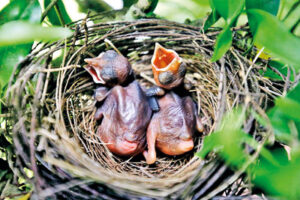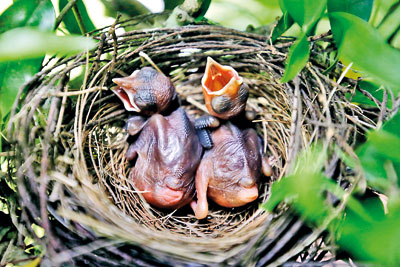
Galle’s wonderland that is ‘Serengeti’ By Kumudini Hettiarachchi
Sitting atop Galgamu-kanda, accessed by a winding, steep pathway is ‘Serengeti’ in Walahanduwa, with a view of the sea off Galle in the hazy and sunny distance.
‘Serengeti’ surrounded by lush greenery, large trees giving a wide canopy, smaller trees, plants, bushes and undergrowth is the home of Sarath and Premila Seneviratne.
Nay, it is not just the home of this retired couple, but also of bees, butterflies, birds and various small mammals.
It is a veritable birds’ paradise as we sit on the verandah sipping a delicious home-made drink from fruit picked from the garden with kasa-kasa temptingly at the top before a sumptuous luncheon, with a spread of vegetables also from the garden.
Suddenly, we hear the hungry chirping of baby birds and Sarath, with finger to lips, gently moves the branches of a kiri nuga bush near my chair to reveal a nest of the Red-vented bulbul with two nestlings in it.
A retired banker who has worked in remote areas, Sarath developed a passion for nature when his mother gifted him his very first book on birds when he was about seven years old and studying at St. Aloysius College, Galle. Their family home was at Hikkaduwa and he would keep cotton for birds such as bulbuls to take and make their nests. He would use the wall of his home as a marking-board to detail when eggs nestled within and when they would bring forth the babies. Later, as the family grew, he would keep a small bench to gain height to see the parent-birds feeding their young.
Being from a family of nine, Sarath who was the fifth boy says that there was no money for lavish spending and it was the pocket money for tiffin that he saved, when living with his Punchi Amma as it was closer to school. He would also ramble up the ramparts in search of birds, while scanning the newspapers to check out any books that were being published. Then he would make a beeline to the Universal Book Store in Galle to order them.
These precious acquisitions and much more including valuable collector’s items in the form of First Editions (all books of W.W.A. Phillips, G.M. Henry etc) tightly-line a large cupboard in his home. Details about the authors, including yellowed and frayed news-clippings and any letters Sarath had written to them along with the replies have been tenderly pasted on the books. This is while numerous photographs of birds are up on the walls.
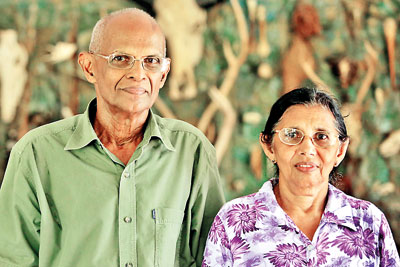
The ‘wild’ trait had seen rapid progression, with Sarath joining the Wildlife and Nature Protection Society (WNPS) way back in 1961 as a schoolboy, being one of its oldest members recognized in 2012 as having an unbroken membership of 50 long years. Soon a request from well-known conservationist Thilo Hoffman — who has been credited with being the saviour of Sinharaja against its rape – had followed to join the Bird Club which he did most willingly in 1975.
Nature lovers: Sarath and Premila
Sarath had also palled up with well-known author T.S.U de Zilwa and in an era when digital photography was still unheard of, to enable the ‘capture’ of bird-images in their different forms of nesting, feeding et al, would provide photography hides for him. (Such ‘hides’ are purpose-made constructions for a photographer to get closer to a bird than would be normally possible if he was in full view.)
“We would take-off on such missions over the weekend, build high scaffoldings and use the ‘hides’,” laughs Sarath going down memory lane to Kumana, Bundala and other locations where birds were aplenty.
These numerous images so captured adorn T.S.U’s lovely books.
Before we go on a tour of the nature wonderland that is ‘Serengeti’, Premila, goes back to those early days. They had fallen in love with the land but there was no water or electricity. Their very first action in the early ’70s was to construct a small tank for rain-water harvesting and then sit and think how they would lug the building materials needed for their home up the hill.
It was Premila who moved into their partially-built home with their eldest son, 10-month-old Hemantha. Two more sons enriched their family, Sampath (who incidentally has taken up molecular ecology and evolution as a Research Scientist & Senior Lecturer in Zoology at the University of Colombo) born in 1977 and Leelanga in 1980.
Gradually, Sarath and Premila turned this patch of land into an exotic beauty-spot — like its namesake National Park in Tanzania — where if there is a slight delay, the birds in the wild clamour for their food and recognize their small car, a Viva Elite, as it climbs the last stretch home, giving them a guard-of-honour.
By 1984, Sarath was also very much a part of the team taking the bird census which he continued even in challenging times such as the youth insurrection of 1988-89. Husband and wife would take the essentials including the telescope tied to the motorcycle and a bare minimum of a bottle of water, while their three sons were in school, and follow the trail of birds, once even passing the body of someone who had been killed in the unrest.
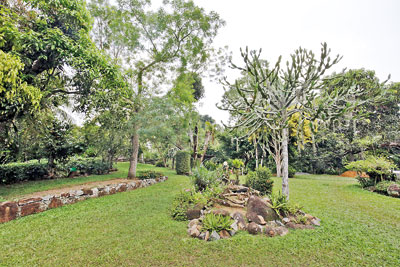
As a gentle breeze moves the foliage this way and that and common mynahs, Rose-ringed parakeets, sunbirds, White-backed munias, Black-hooded orioles and even the rare Yellow-naped green woodpecker fly around, butterflies flit from bush-to-bush, squirrels scurry hither and thither and a thalagoya (iguana) seems to show the way, we walkabout untroubled by the afternoon heat.
From the verandah, our first stop is the ‘amphibian cave’, the hollow of a tree; then passing creepers, bushes, plants and trees such as veni-val, kiri-nuga, magul karanda, an-kenda, uguressa, delum, atteria, all kinds of lime trees, we come upon the ‘bat hollow’ set up for insect-eating bats, and jump over a stile to take a look at the ‘vegetable patch’ of wetakolu (ribbed gourd), maalu-miris (capsicum), wattakka (pumpkin), karawila (bitter-gourd), iringu (corn), rabu (radish), nivithi (spinach) lovingly tended by Premila and then tea-lands and more. The rainwater harvesting tank is still intact but bigger.
Both Sarath and Premila are justifiably proud of the exotic orchids including the Vesak orchid (Dendrobium maccarthiae) and Vanda tessellata they have nurtured.
It is after a long and relaxing afternoon watching myriads of birds at ‘Serengeti’ that we bid goodbye to Sarath and Premila, in total agreement with Sarath that watching birds is a “bavanawa” (meditation) in itself.
By Kumudini Hettiarachchi
Source – 07/05/2017,The Sunday Times, see more at – http://www.sundaytimes.lk/170507/plus/galles-wonderland-that-is-serengeti-239064.html

Fading fortunes of the native Vesak flower
A species of orchid that blooms in May and commonly called Vesak mal is becoming rarer. Plant experts say habitat loss and over collection from the wild are causing its decline.
Scientifically known as dendrobium maccarthiae, it may have got its local name because it blooms in the month of Vesak.
It is a light violet-pink flower with a paler lip and a purple blotch in the centre. It is a larger variety of wild orchid. The flower is about 6 centimetres long and 7.5 cm across. The photos accompanying this article were captured by Bushana Kalhara from the Kukulugala forest patch in Ratnapura two years ago in late May. He says the flowers were on the canopy about six metres above ground.
A specialist on orchids, Dr Suranjan Fernando, says the flower grows in south western lowland forest patches in Ratnapura, Kegalle, Kalutara and Colombo districts. The core area of the distribution is northern and western parts of the Ratnapura and Kalutara districts. It is also found in the western parts of Kegalle, southern part of Colombo and northern part of Galle district.
“The reason that this orchid is not found in other parts of the lowland wet zone is still a mystery,” Dr Fernando says.
Like most of the other wild orchids, it is an epiphyte plant that grows harmlessly on tall trees getting moisture and nutrients from the air, rain, and sometimes from debris accumulating around it. The species usually grows in the upper parts of the tree trunks and large branches of mature trees.
It is a popular Sri Lankan flower and has been featured in stamps issued in 1950 and 1994. The orchid is also the provincial flower of Sabaragamuwa.
The former head of the Botanical Gardens, Dr Siril Wijesundara, reveals that there was a plan to use the Vesak orchid as a local alternative to the poppy to commemorate war heroes following the end of the war against Tamil terrorists in 2009.
It has caught the attention of collectors and exporters since the colonial days because it is endemic to Sri Lanka. Collecting the orchids from the wild for ornamental purposes led to its decline in the 1900s. This led to its listing as a protected species from 1937 with the inception of the Fauna and Flora Ordinance. Even the Forest Ordinance protects the Vesak orchid.
The former head of the Customs Biodiversity Unit, Samantha Gunasekara who is also an orchid lover says he once saw an ad on e-Bay that listed a plant for sale.
He was certain that it had been gathered from the wild.
Dr Fernando says field observations in the past 10 years have shown that the flower is in decline.
A number of other wild orchids are also threatened.
In Sri Lanka, orchidaceae is among the largest families in the country with 191 known species with 57 endemic species. Orchids grow in many habitat types in Sri Lanka, but highest number has been recorded in diverse ecosystems found in the wet zone.
According to the 2012 National Red List of Threatened Fauna and Flora, four orchid species are likely to be ‘possibly extinct’ as they have not been recorded for a considerable time. Sixteen species are ‘critically endangered’, threatened with becoming extinct, while 54 species are categorised as ‘endangered’. And 60 species fall into the ‘vulnerable’ category.
A number of showy orchids are also in demand. The Red List 2012 lists phaius wallichii (star orchid), rhynchostylis retusa (fox tail), and vanda tessellata are commonly collected by growers and flower enthusiasts. Habenaria crinifera (naarilatha), ipsea speciosa (nagamaru ala), anoectochilus spp. (wanaraja), zeuxine spp. (iruraja), are taken from the wild for medicinal purposes and because of various mythological beliefs associated with each species.
Source – 087/05/2017/ The Sunday Times, See more at – http://www.sundaytimes.lk/170507/news/fading-fortunes-of-the-native-vesak-flower-239451.html
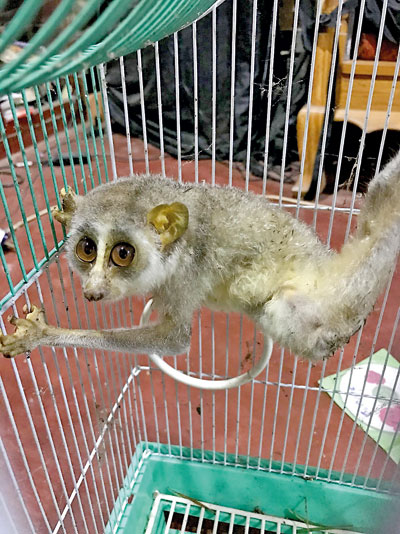
Declining loris populations risk lives on power lines
The rescued loris. Pic by Tharindi Pathirana An electrocuted loris. Pic by Chaminda Jayasekara
As tall trees in urban gardens become rarer, the loris appears to find electric wires an alternative way to move around. But many end up being electrocuted.
One lucky loris that got stuck on a power utility post last Monday was rescued in Anuradhapura town.
Young Tharindi Pathirana who lives near the SOS Children’s Village in Anuradhapura town heard screams around 9:00 pm. It lasted about 20 minutes. With her father’s help she began looking around and they found the frightened creature. But, by the time they reached the location, it had fallen to the ground. They took it home and alerted the wildlife officers, but they could not come until the following day to take custody of the animal.
Sri Lanka is home to two species of loris, namely, the gray slender loris and the red slender loris. These species have two subspecies, each restricted to various parts of Sri Lanka.
The Sunday Times contacted Chaminda Jayasekara – the naturalist of Vil Uyana hotel who also published a book about the loris to help identify the species that was saved in Anuradhapura. He identified the animal as a grey slender loris, which belongs to a subspecies scientifically categorized as loris lydekkerianus nordicus.
“I have come across at least five loris deaths due to electrocutions during the past six months. Last March, I saw a loris death at Kaduruwela in Polonnaruwa,” Mr Jayasekara says. He lists Polonnaruwa, Girithale, Anuradapura, Mihinthale as areas in which electrocutions occur often.
A number of loris have been seen in urban settings where power lines are abundant and it seems these insect hunters use the utility posts and lamp posts as places to find prey.
Mr Jayasekara also said he had witnessed a number of loris killed in collissons with vehicles on roads.
Loris researcher Saman Gamage says translocating these animals should be done with caution as there are a number of subspecies in various parts of the country. Translocating could result in species mixing.
Mr Gamage points out that loris populations can survive in many isolated patches of forest, but the numbers are declining.
By Malaka Rodrigo
Source – 07/05/2017, The Sunday Times – http://www.sundaytimes.lk/170507/news/declining-loris-populations-risk-lives-on-power-lines-239405.html

Hambantota elephants face bleak future
In a sad example of the plight of elephants in the Hambantota district, yet another animal alleged to have damaged properties and crops of residents in Kuda Indiwewa, Suriyawewa and Hambantota, was captured yesterday (4) and taken to Horowpathana elephant holding center.
The elephant was the 20th to be captured from the district and taken to the holding center.
Environmentalists say the holding center, which is spread across 2900 acres, lacks the necessary space and food needed for the elephants. Moreover, since only large and strong male elephants are held at the center, it removes elephants with good genes from the wild, which has a negative impact on the elephant gene pool.
They also claim that male elephants newly taken to the holding center risk being attacked by other males. There have even been reports of some elephants being badly injured in these attacks. The reason for the attacks is that the holding center does not have enough female elephants to meet the reproductive needs of the males.
Wildlife officers said the elephant captured yesterday was a large male about nine feet tall and about 35 years old.
Area residents say about 15 houses in the Suriyawewa area alone have been damaged during the last three weeks due to elephant attacks.
Officers from the Department of Wildlife Conservation’s (DWC) Hambantota office said they had no option but to capture the elephant as area residents were demanding it as the animal was damaging their properties.
According to the DWC, the number of wild elephants in the Hambantota district have increased from about 350 to 400 during the last 10 years. However, while elephant numbers have increased, their habitat has gradually shrunk, leading to more human-elephant conflict.
Available data reveals 25 persons in the Hambantota district have been killed from 2010 to 2017 due to elephant attacks. The number of properties damaged by elephants during the same period is 347. Meanwhile, 58 elephants have been killed at the hands of humans.
Story and Pix by Rahul Samantha Hettiarachchi
Source – Times Online, See more at –
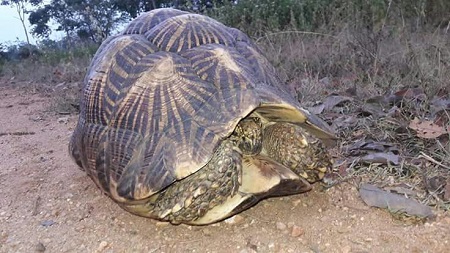
Largest star tortoise in Sri Lanka found from Lunugamvehera
The largest star tortoise ever recorded in Sri Lanka has been found from the Lunugamvehera National Park. The tortoise is 45cm in carapace length (carapace is the hard upper shell) with a shell height of 22cm and a Paltron length of 42cm. It weighs 13.93kg.
There is speculation that the tortoise may even be the largest star tortoise in the world.
Wildlife Veterinarian at the Department of Wildlife Conservation (DWC), Dr. Vijitha Perera is currently examining the tortoise to verify whether this is indeed the case.
By Rahul Samantha Hettiarachchi
Source Times Online, 06/05/2017See more at – http://www.sundaytimes.lk/article/1021401/largest-star-tortoise-in-sri-lanka-found-from-lunugamvehera

